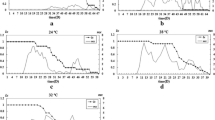Abstract
Investigations on longevity and fertility of Megastigmus bipunctatus Swederus (Hym., Chalc., Torymidae)
Investigations on the influence of different climatic and nutritional factors on longevity and fertility of adult femaleMegastigmus bipunctatus showed that differences in relative humidity had little effect. In higher temperatures longevity and fertility were reduced; the number of undeveloped eggs was reduced more than the number of mature eggs. Food formulas containing protein in the form of chicken egg albumen had a negative effect on longevity and fertility when compared with data fromM. bipunctatus femals kept without food and water. An increase of both, life span and number of eggs, was observed after giving distilled water, aqueous honey solution or aqueous honey solution enriched with vitamin mixture. A maximum increase was obtained with femals living only on honey solution.
Similar content being viewed by others
Literaturverzeichnis
Göttsche, A.-B., 1976: Ein Beitrag zur Lebensweise vonMegastigmus bipunctatus Swederus, Diss. Forstl. Fak., Univ. Göttingen.
Hedlin, A. F., 1956: Studies on the Balsam-Fir Seed Chalcid,Megastigmus specularis Walley (Hymenoptera, Chalcididae). Can. Ent.88, 691–697.
Hussey, N. W., 1955: The life-histories ofMegastigmus spermotrophus Wachtl (Hymenoptera, Chalcidoidea) and its principal parasite, with descriptions of the developmental stages. Trans. Roy. Ent. Soc. London106, 133–151.
Hussey, N. W., 1956: The extend of seed-loss in Douglas- Fir caused byMegastigmus. Scott. For.10, 191–197.
Lessmann, D., 1971: Ein Beitrag zur Verbreitung und Lebensweise vonMegastigmus spermotrophus Wachtl undMegastigmus bipunctatus Swederus. Diss. Forstl. Fak., Univ. Göttingen.
Romeis, B., 1968: Mikroskopische Technik, 16. Aufl., Oldenbourg Verlag München-Wien.
Skrzypczynska, M., 1973: Zwei Parasitenarten (Hym., Chalc.) Eupelmidae und Pteromalidae vonMegastigmus pictus (Först.) (Hym., Chalc., Torymidae) in Lärchensamen. Anz. Schädlingskde.46, 60–61.
Voute, A. D., 1936: Die Entwicklung der Mehlmotte,Ephestia kühniella Zell., bei konstanten und schwankenden Temperaturen, Teil2, Z. ang. Ent.22, 165–184.
Zwölfer, W., 1931: Studien zur Ökologie und Epidermiologie der Insekten - 1. Die Kieferneule,Panolis flammea Schiff. Z. ang. Ent.17, 475–562.
Author information
Authors and Affiliations
Rights and permissions
About this article
Cite this article
Göttsche, Ab. Untersuchungen über Lebensdauer und Eivorrat der Wacholdersamenwespe Megastigmus bipunctatus Swederus (Hym., Chalc., Torymidae). Anz. Schadlingskde., Pflanzenschutz, Umweltschutz 50, 40–45 (1977). https://doi.org/10.1007/BF02135077
Issue Date:
DOI: https://doi.org/10.1007/BF02135077




